TOYOTA PRIUS 2009 2.G Owners Manual
Manufacturer: TOYOTA, Model Year: 2009, Model line: PRIUS, Model: TOYOTA PRIUS 2009 2.GPages: 508, PDF Size: 6.84 MB
Page 371 of 508
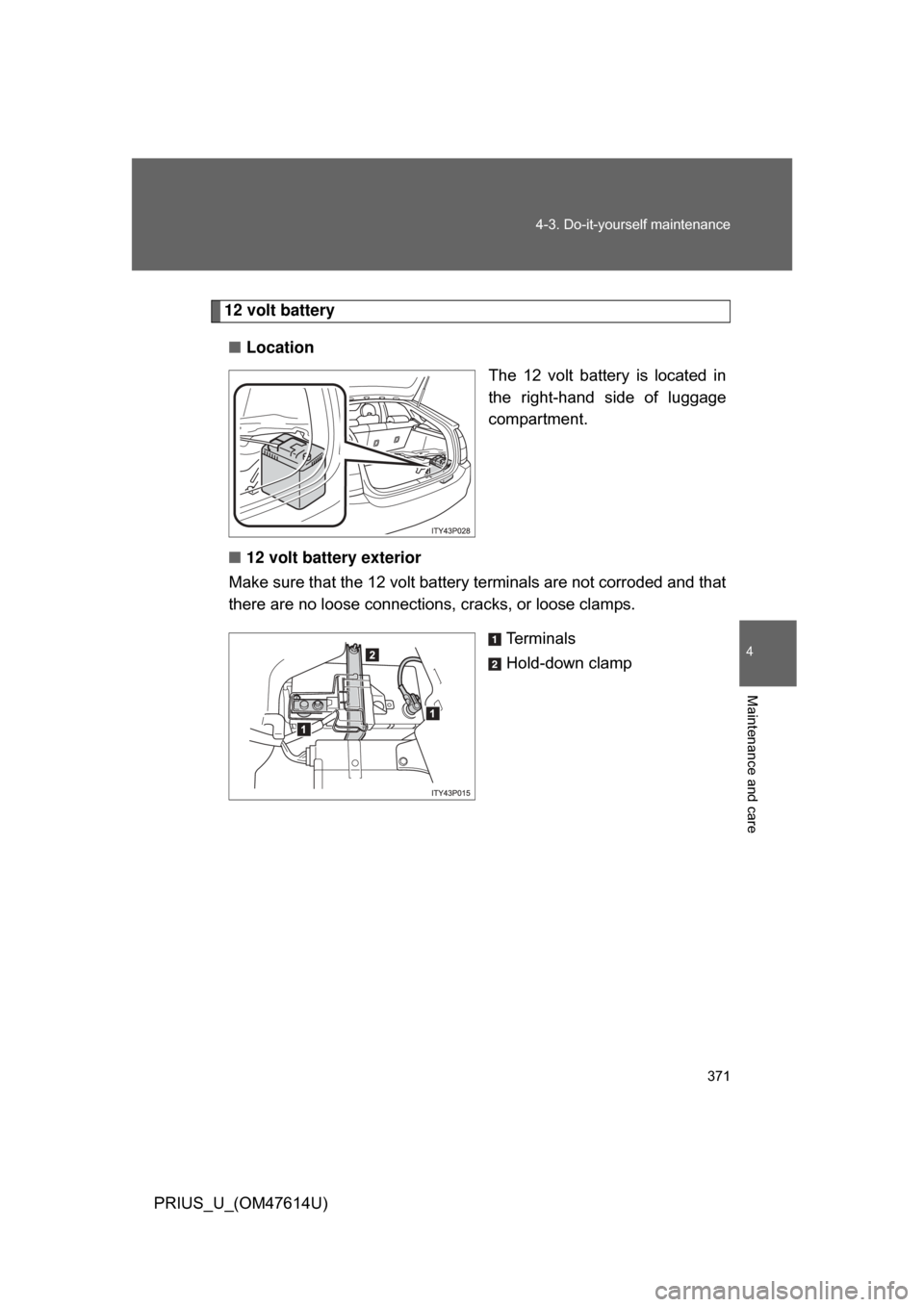
371
4-3. Do-it-yourself maintenance
4
Maintenance and care
PRIUS_U_(OM47614U)
12 volt battery
■ Location
The 12 volt battery is located in
the right-hand side of luggage
compartment.
■ 12 volt battery exterior
Make sure that the 12 volt battery terminals are not corroded and that
there are no loose connections, cracks, or loose clamps.
Te r m i n a l s
Hold-down clamp
Page 372 of 508

372 4-3. Do-it-yourself maintenance
PRIUS_U_(OM47614U)
■Before recharging
When recharging, the 12 volt battery produces hydrogen gas which is flam-
mable and explosive. Therefore, before recharging:
● If recharging with the 12 volt battery installed on the vehicle, be sure to
disconnect the ground cable.
● Make sure the power switch on the charger is off when connecting and
disconnecting the charger cables to the 12 volt battery.
■ After recharging/reconnecting the 12 volt battery
In some cases, the hybrid system may not start. Follow one or both of the
following procedures:
● After opening and closing the driver’s door, wait 10 seconds then attempt
to start the engine. (If the system does not start first time, repeat the pro-
cedure.)
● With the shift lever in “P” and the “POWER” switch in the OFF mode,
open and close any door, then attempt to start the hybrid system.
If the system will not start even after multiple attempts at both methods, con-
tact your Toyota dealer.
Page 373 of 508
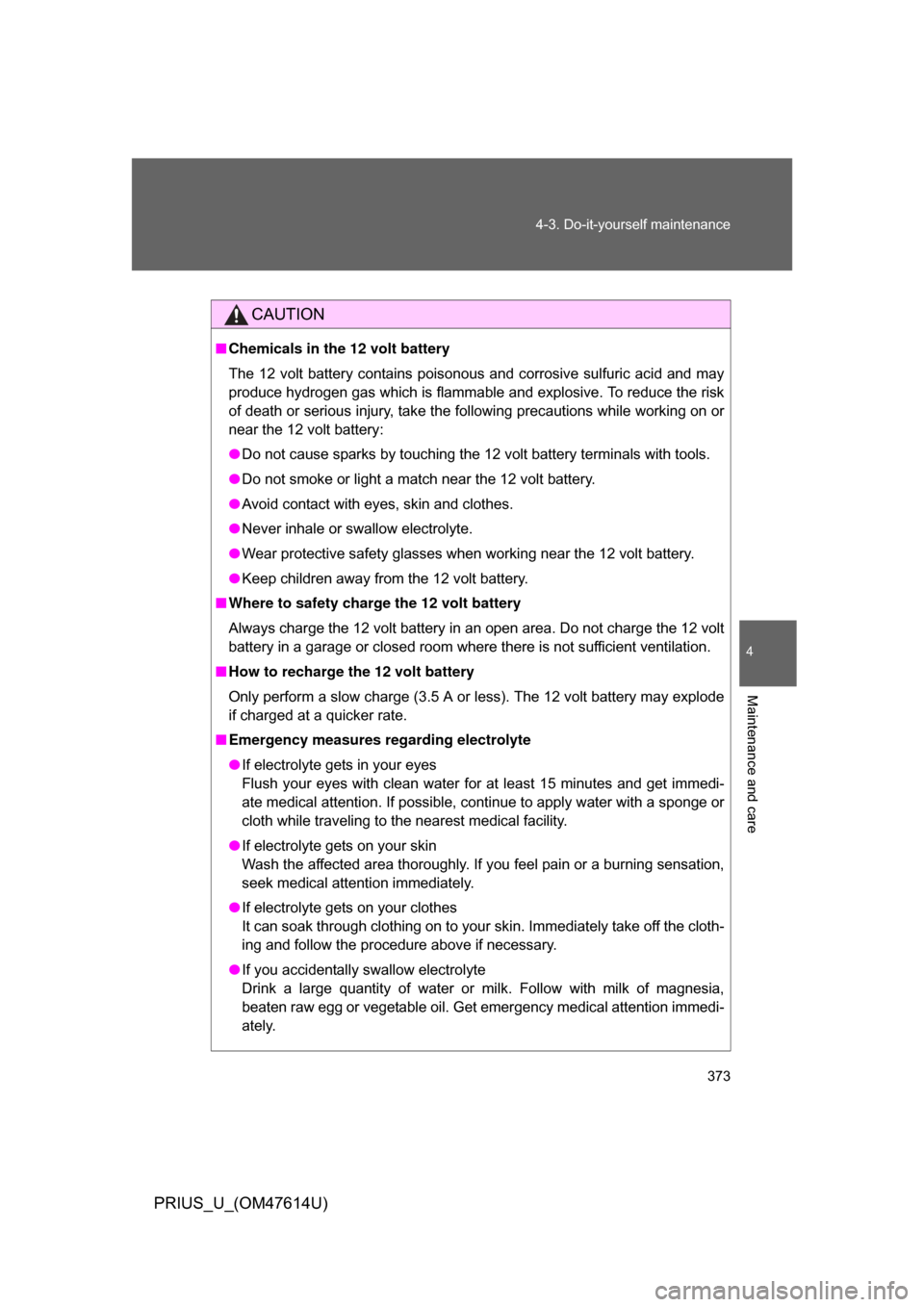
373
4-3. Do-it-yourself maintenance
4
Maintenance and care
PRIUS_U_(OM47614U)
CAUTION
■
Chemicals in the 12 volt battery
The 12 volt battery contains poisonous and corrosive sulfuric acid and may
produce hydrogen gas which is flammable and explosive. To reduce the risk
of death or serious injury, take the following precautions while working on or
near the 12 volt battery:
● Do not cause sparks by touching the 12 volt battery terminals with tools.
● Do not smoke or light a match near the 12 volt battery.
● Avoid contact with eyes, skin and clothes.
● Never inhale or swallow electrolyte.
● Wear protective safety glasses when working near the 12 volt battery.
● Keep children away from the 12 volt battery.
■ Where to safety charge the 12 volt battery
Always charge the 12 volt battery in an open area. Do not charge the 12 volt
battery in a garage or closed room where there is not sufficient ventilation.
■ How to recharge the 12 volt battery
Only perform a slow charge (3.5 A or less). The 12 volt battery may explode
if charged at a quicker rate.
■ Emergency measures regarding electrolyte
● If electrolyte gets in your eyes
Flush your eyes with clean water for at least 15 minutes and get immedi-
ate medical attention. If possible, continue to apply water with a sponge or
cloth while traveling to the nearest medical facility.
● If electrolyte gets on your skin
Wash the affected area thoroughly. If you feel pain or a burning sensation,
seek medical attention immediately.
● If electrolyte gets on your clothes
It can soak through clothing on to your skin. Immediately take off the cloth-
ing and follow the procedure above if necessary.
● If you accidentally swallow electrolyte
Drink a large quantity of water or milk. Follow with milk of magnesia,
beaten raw egg or vegetable oil. Get emergency medical attention immedi-
ately.
Page 374 of 508
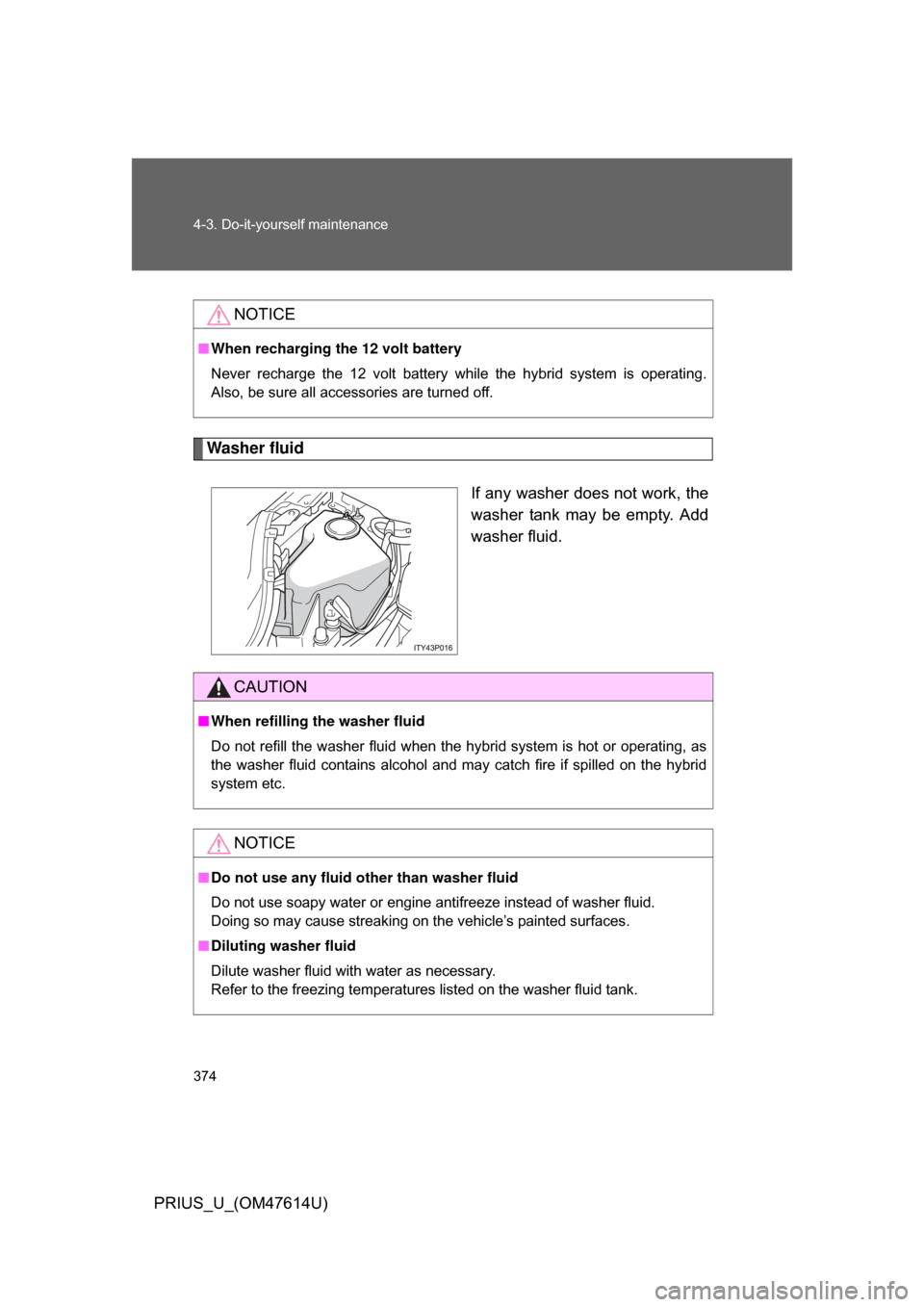
374 4-3. Do-it-yourself maintenance
PRIUS_U_(OM47614U)
Washer fluidIf any washer does not work, the
washer tank may be empty. Add
washer fluid.
NOTICE
■When recharging th e 12 volt battery
Never recharge the 12 volt battery while the hybrid system is operating.
Also, be sure all accessories are turned off.
CAUTION
■ When refilling the washer fluid
Do not refill the washer fluid when the hybrid system is hot or operating, as
the washer fluid contains alcohol and may catch fire if spilled on the hybrid
system etc.
NOTICE
■Do not use any fluid other than washer fluid
Do not use soapy water or engine antifreeze instead of washer fluid.
Doing so may cause streaking on the vehicle’s painted surfaces.
■ Diluting washer fluid
Dilute washer fluid with water as necessary.
Refer to the freezing temperatures listed on the washer fluid tank.
Page 375 of 508
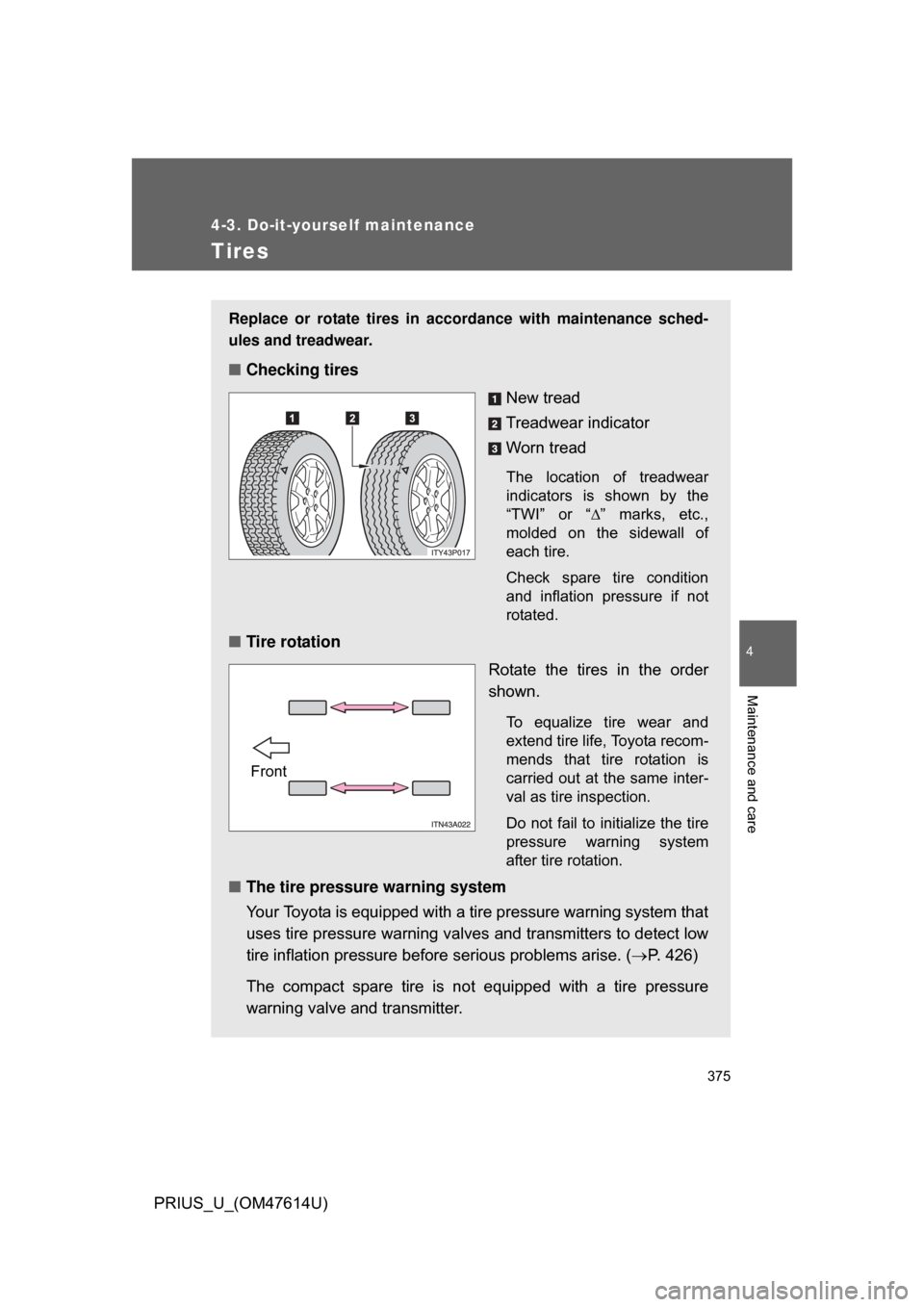
375
4-3. Do-it-yourself maintenance
4
Maintenance and care
PRIUS_U_(OM47614U)
Tires
Replace or rotate tires in accordance with maintenance sched-
ules and treadwear.
■Checking tires
New tread
Treadwear indicator
Worn tread
The location of treadwear
indicators is shown by the
“TWI” or “” marks, etc.,
molded on the sidewall of
each tire.
Check spare tire condition
and inflation pressure if not
rotated.
■ Tire rotation
Rotate the tires in the order
shown.
To equalize tire wear and
extend tire life, Toyota recom-
mends that tire rotation is
carried out at the same inter-
val as tire inspection.
Do not fail to initialize the tire
pressure warning system
after tire rotation.
■The tire pressure warning system
Your Toyota is equipped with a tire pressure warning system that
uses tire pressure warning valves and transmitters to detect low
tire inflation pressure before serious problems arise. (P. 426)
The compact spare tire is not equipped with a tire pressure
warning valve and transmitter.
Front
Page 376 of 508

376 4-3. Do-it-yourself maintenance
PRIUS_U_(OM47614U)
Installing tire pressure warning valves and transmittersWhen replacing tires or wheels, tire pressure warning valves and
transmitters must also be installed.
When new tire pressure warning valves and transmitters are
installed, new tire pressure warn ing valve and transmitter ID codes
must be registered in the tire pr essure warning computer and tire
pressure warning system must be initialized. Have tire pressure
warning valve and transmitter ID codes registered by Toyota dealer.
( P. 378)
Initializing the tire pressure warning system
■ The tire pressure warning system must be initialized in the fol-
lowing circumstances:
●When rotating the tires on vehicles differing with front and rear
tire inflation pressures.
● When changing the tire inflation pressure by changing traveling
speed or load weight, etc.
● When changing the tire size.
When the tire pressure warning system is initialized, the current
tire inflation pressure is set as the pressure benchmark.
Page 377 of 508
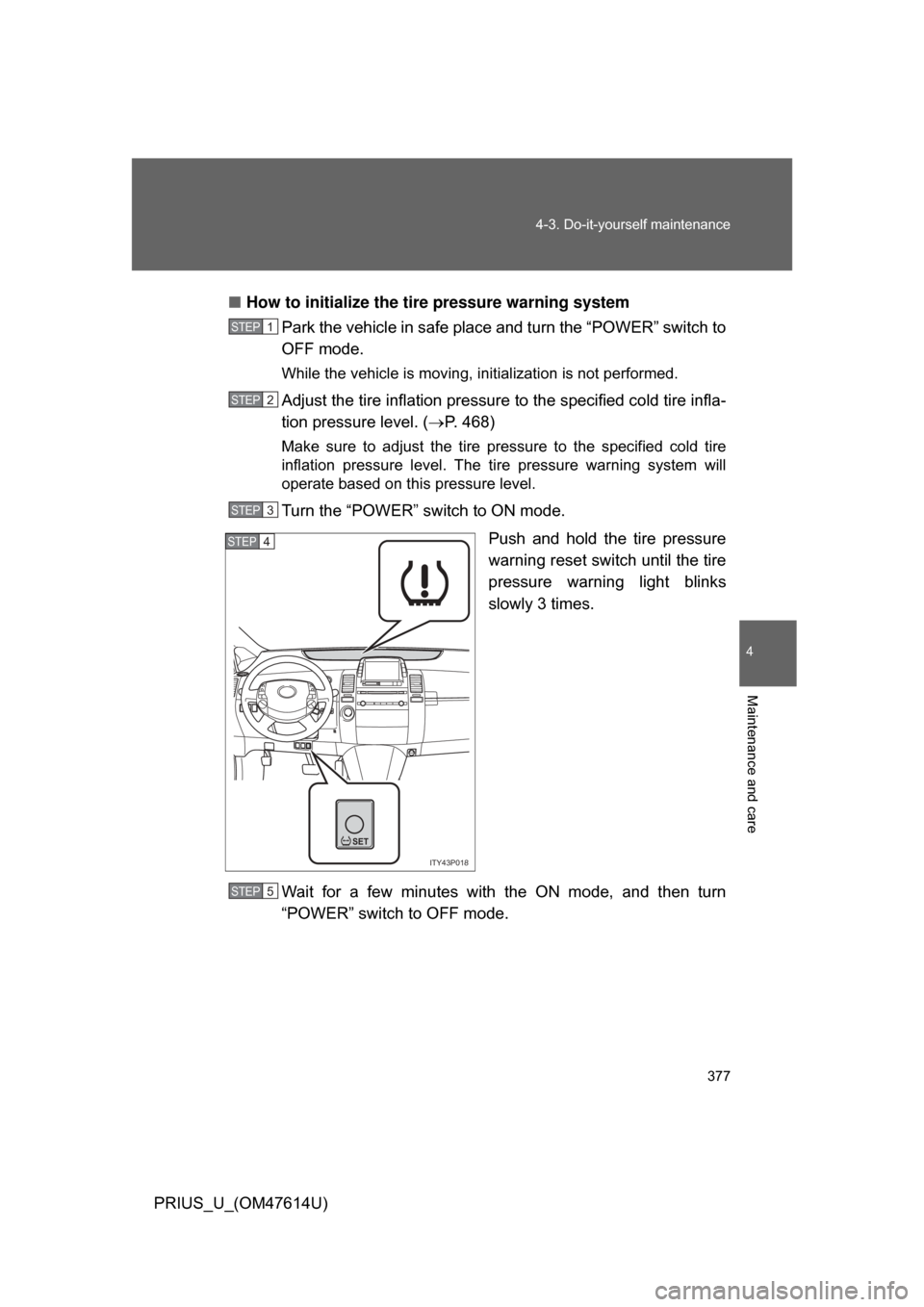
377
4-3. Do-it-yourself maintenance
4
Maintenance and care
PRIUS_U_(OM47614U)
■
How to initialize the tire pressure warning system
Park the vehicle in safe place and turn the “POWER” switch to
OFF mode.
While the vehicle is moving, in itialization is not performed.
Adjust the tire inflation pressure to the specified cold tire infla-
tion pressure level. ( P. 468)
Make sure to adjust the tire pressure to the specified cold tire
inflation pressure level. The ti re pressure warning system will
operate based on this pressure level.
Turn the “POWER” switch to ON mode.
Push and hold the tire pressure
warning reset switch until the tire
pressure warning light blinks
slowly 3 times.
Wait for a few minutes with the ON mode, and then turn
“POWER” switch to OFF mode.
STEP1
STEP2
STEP3
SET
ITY43P018
STEP4
STEP5
Page 378 of 508

378 4-3. Do-it-yourself maintenance
PRIUS_U_(OM47614U)
Registering ID codesThe tire pressure warning valve and transmitter is equipped with a
unique ID code. When replacing a tire pressure warning valve and
transmitter, it is necessary to regi ster the ID code of tire pressure
warning valve and transmitter. Have the ID code registered by your
Toyota dealer.
■When to replace your vehicle’s tires
Tires should be replaced if:
●You have tire damage such as cuts, splits, cracks deep enough to
expose the fabric or bulges indicating internal damage
●A tire goes flat repeatedly or c annot be properly repaired due to the
size or location of a cut or other damage
If you are not sure, consult with your Toyota dealer.
■Replacing tires and wheels
If the ID code of the tire pressure warning valve and transmitter is not
registered, the tire pre ssure warning system will not work properly. After
driving for about 20 minutes, the ti re pressure warning light comes on
after blinking for 1 minute to indicate a system malfunction.
■Tire life
Any tire over 6 years old must be checked by a qualified technician even
if they have seldom or never been used or damage is not obvious.
■If the tread wears down below 0.16 in. (4 mm) on snow tires
The effectiveness of snow tires is lost.
■Maximum load of tire
Check that the maximum load of the re placed tire is greater than 1/2 of
the Gross Axle Weight Ratings (GAWR) of either the front axle or the
rear axle, whichever is greater.
As for the maximum load of the tire, see the load limit at maximum cold
tire inflation pressure mentioned on the sidewall of the tire, and as for the
Gross Axle Weight Ratings (GAWR) , see the Certification Label.
(
P. 384, 473).
Page 379 of 508

379
4-3. Do-it-yourself maintenance
4
Maintenance and care
PRIUS_U_(OM47614U)
■Tire types
1 Summer tires
Summer tires are high-speed performance tires best suited to highway
driving under dry conditions. Since summer tires do not have the same
traction performance as snow tire s, summer tires are inadequate for
driving on snow-covered or icy roads. For driving on snow-covered
roads or icy roads, the use of snow tires is recommended. When
installing snow tires, be sure to replace all four tires.
2 All season tires All season tires are designed to provide better traction in snow and to
be adequate for driving in most winter conditions, as well as for use
year round. All season tires, however, do not have adequate traction
performance compared with snow tires in heavy or loose snow. Also,
all season tires fall short in acceleration and handling performance
compared with summer tires in highway driving.
3Snow tires
For driving on snow-covered roads or icy roads, we recommend using
snow tires. If you need snow tires, select tires of the same size, con-
struction and load capacity as the or iginally installed tires. Since your
vehicle has radial tires as original equipment, make sure your snow
tires also have radial construction. Do not install studded tires without
first checking local regulations for possible restriction. Snow tires
should be installed on all wheels. ( P. 173)
■Initializing the tire pressure warning system
Initialize the tires with the tire inflation pressure adjusted to the specified
level.
Page 380 of 508

380 4-3. Do-it-yourself maintenance
PRIUS_U_(OM47614U)
■If you push the tire pressure warning reset switch accidentally
If initialization is performed, adjust the tire in flation pressure to the speci-
fied level and initialize the tire pressure warning system again.
■When the initialization of the tire pressure warning system has
failed
Initialization can be completed in a few minutes. However, in the follow-
ing cases, the settings have not b een recorded and the system will not
operate properly. If repeated attempts to record tire inflation pressure
settings are unsuccessful, have the vehicle inspected by your Toyota
dealer.
●When operating the tire pressure warning reset switch, the tire pres-
sure warning light does not flash 3 times.
●After carrying out the initialization procedure, the tire pressure warn-
ing light blinks for 1 minute then stays on after driving 20 minutes.
■Routine tire inflation pressure checks
The tire pressure warning system doe s not replace routine tire inflation
pressure checks. Make sure to check tire inflation pressure as part of
your routine of daily vehicle checks.